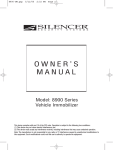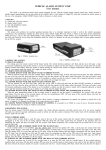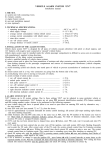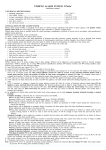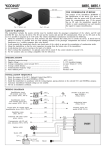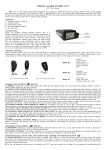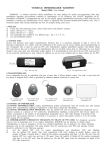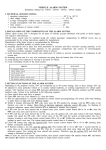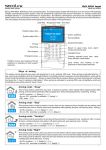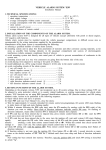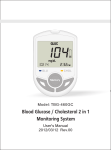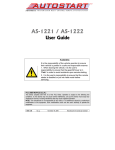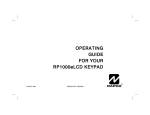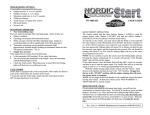Download VEHICLE ALARM SYSTEM `GN7C`
Transcript
VEHICLE ALARM SYSTEM 'GN7C'
User's manual
The 'GN7C' is an advanced vehicle alarm system designed for cars with the original remote control central lock and the CAN-BUS.
'GN7C' provides a reliable engine immobilization for the prevention of the vehicle's theft. It also features a 4-digit PIN code that overrides
the alarm system in the case of an emergency, built-in ultrasonic and / or tilt / shock sensor(s).
1. THE SET.
a) system unit with wire harness;
b) engine bonnet switch;
c) user and installation manual;
d) siren (optional).
2. SYSTEM UNIT.
The system unit performs the essential guarding functions thus it
is extremely important to hide it well in the vehicle's passenger
compartment. The manufacturer supplies the alarm system with a
default 4-digit PIN code, which is written on the alarm system
information sticker (see Fig. 1). The user should change it into
another, more memorable, 4-digit number. It is recommended to
write down the new PIN code, however, do not keep this
information inside the vehicle. In addition, do not use your birthday
date or home address numbers for the PIN for security.
Sticker
Date
PIN code
Fig. 1. The information sticker and the PIN code.
3. ARMING THE SYSTEM.
3.1. REGULAR ARMING.
For arming, press the remote control LOCK button shortly. The vehicle direction indicators will flash and the siren will make a short
(0.1 second) confirmation sound (if this feature is set by the installer) to inform you that the system is armed. The system LED will go ON,
making constant short flashes. When the system is armed, opening the vehicle's door, bonnet or luggage compartment, vehicle's body
tilt/impact to the vehicle’s body or a movement inside the vehicle will trigger the alarm system.
3.2. ARMING WITH SENSOR BYPASS.
3.2.1. SENSOR BYPASS WITH THE HELP OF THE OVERRIDE BUTTON.
With the ignition turned OFF press the override button. Watch the system's LED, its flash will mean that the press has been confirmed.
Get out the car, close the doors and lock the Central Lock with the remote's LOCK button within 20 seconds. The siren will make a long
(0.5 second) confirmation sound (if this feature is set by installer) to inform you that the system is armed with a bypassed ultrasonic and/or
tilt/shock sensor(s) and the movement inside the car and/or car's body tilt/impact to car's body will not trigger the alarm.
3.2.2. SENSOR BYPASS WITH THE HELP OF THE IGNITION KEY.
Turn the ignition ON and OFF three times. Watch the system LED, its flash will mean that the third ON/OFF procedure is confirmed.
Get out the car, close the doors and lock the Central Lock with the remote's LOCK button within 20 seconds. The siren will make a long
(0.5 second) confirmation sound (if this feature is set by installer) to inform you that the system is armed with a bypassed ultrasonic and/or
tilt/shock sensor(s) and that movement inside the car and/or car's body tilt/impact to car's body will not trigger the alarm.
3.2.3. SENSOR BYPASS WITH THE HELP OF THE OVERRIDE BUTTON WHEN THE IMMOBILIZER IS ACTIVE.
When the inner immobilizer feature of the car alarm system is turned ON and the engine is immobilized, the system's LED will emit
long flashes. First press of the override button which will turn the immobilization OFF. The next press of the override button will start the
bypassing procedure as described in chapter 3.2.1.
3.3. ALARM INTERRUPTION.
The system will trigger the alarm if the vehicle's doors, bonnet or luggage compartment are opened, the ignition is turned ON or the
ultrasonic sensor is triggered. To interrupt the alarming of the system disarm and re-arm it.
4. DISARMING THE SYSTEM.
Press the remote control UNLOCK button once shortly. The vehicle direction indicators will flash and the siren (if it was set by installer)
will make two short (0.1 second) confirmation sounds to inform you that the system is disarmed. The system's LED will turn OFF.
5. THE OVERRIDE MODE.
Alarm system override mode is used for cases such as the loss of the remote control unit, the remote's battery becoming completely
discharged or in the case of the car being repaired. With this mode ON, the alarm system does not respond to the sensor(s), does not
immobilize the engine and does not alarm (N.B. the system's LED flashes frequently). The override mode can be turned ON in two ways
with the PIN code.
5.1. TURNING ON THE OVERRIDE MODE WITH THE HELP OF THE OVERRIDE BUTTON.
The most convenient way to turn ON the override mode is to enter the PIN code with the override button. If the override button is
installed, check your notes with the alarm system's PIN on, press the override button as many times as the value of the first digit of the PIN
(the time between the presses should not exceed 1 second) and wait for a 1 second lasting LED flash, which will mean that the first digit is
entered successfully. In the same way enter the second, third and fourth digits of the PIN. If the 'anti-carjack' or immobilizer features are
activated, the system will respond to the first press of the override button as to the control of the 'anti-carjack' or the immobilizer functions.
To the next presses of the override button the system will respond as if the PIN code is being entered.
5.2. TURNING ON THE OVERRIDE MODE WITH THE IGNITION KEY.
If the override button is not installed, open the vehicle's door and turn the ignition ON. Shortly after the system LED starts flashing
double flashes, count until the number of double flashes (1 double flash = 1 unit) corresponds with the first digit of the PIN code. Turn the
ignition OFF for a short time and turn it ON again. Count the double flashes until the number corresponds with the second digit of the PIN
code. Turn the ignition key OFF and ON again. Enter the remaining two digits of the PIN code in the same way. Upon correct entry of all
four digits of the PIN code the LED emits frequent flashes. If you make a mistake while entering the PIN code, turn OFF the ignition, close
the doors, and follow 5.2 all over again.
5.3. TURNING OFF (EXIT) THE OVERRIDE MODE.
Enter the PIN code and enter the code '11' in a way as described in 5.1 or 5.2 within 8 minutes of the previous step.
5.4. CHANGING THE PIN CODE.
The user has a possibility to change the PIN code. In order to do that, do the following steps:
a) enter the current PIN code, the system's LED will emit single flashes frequently;
b) in the same way as the PIN was entered before, enter the code '88'. The entry will be confirmed by a short flash of direction indicators;
c) within 8 minutes of the previous step enter the new PIN twice, one after another. In a case the same code was entered twice, the system
will record this as the new PIN code and confirm it by a short siren sound;
d) if a mistake is made while entering the PIN code, the system will inform you by a short flash of the direction indicators. Wait for the
frequent flashes of the system's LED and follow the steps from 5.4 c all over again.
2. EXTRA FEATURES.
The extra features allows you to have an increased level of security for the car and the driver if it is required. The installer will
comment which extra feature is turned ON.
6.1. INNER IMMOBILIZER.
With the inner immobilizer feature of the alarm system turned ON the engine immobilization will start each time the alarm system is
disarmed or the ignition is turned OFF and the engine immobilization delay time (default time is set at 40 seconds) is elapsed. The GN7C
indicates the engine immobilization by a long system's LED flashes. Engine immobilization should be cancelled by pressing the override
button. Then the system's LED will go OFF.
6.2. PROTECTION AGAINST ROBBERY ('ANTI-CARJACK').
It is allowed to use this feature if the vehicle is operated outside the EU or in countries, which do not apply the UNECE Regulation
No 97. Six different modes of 'anti-carjack' feature are available:
6.2.1. 'Anti-carjack' activated by turning the ignition ON. The alarm system will stop a car.
After turning the ignition ON it is necessary to press the override button (cancel the 'anti-carjack'). The cancelling of the 'anti-carjack' is
confirmed by a LED flash lasting 1 second. If the 'anti-carjack' is not cancelled until pre-set time (default is 40 seconds) is elapsed the siren
will start to sound and direction indicators will start to flash. After the next 10 seconds the engine will be immobilized and the alarm system
will rearm automatically. If the system was rearmed, in order to disarm it press the remote's UNLOCK button and the override button.
6.2.2. 'Anti-carjack' activated by turning the ignition ON or by opening the driver's door with ignition ON. The alarm system will
stop a car.
'Anti-carjack' action is same as described in 6.2.1, except after turning the ignition ON or opening the driver's door with ignition ON it is
necessary to press the override button (cancel the 'anti-carjack').
6.2.3. 'Anti-carjack' activated by turning the ignition ON or by opening any door with ignition ON. The alarm system will stop a car.
'Anti-carjack' action is same as described in 6.2.1, except after turning the ignition ON or opening any door with ignition ON it is
necessary to press the override button (cancel the 'anti-carjack').
6.2.4. Also available 3 'anti-carjack' modes when the alarm system will not stop a car.
The modes are permitted for use in EU. The modes is the same as described in 6.2.1, 6.2.2, 6.2.3 accordingly except: the siren will start
to sound and direction indicators will start to flash. The engine will be immobilized only after the ignition is turned OFF and the alarm
system will rearm automatically.
6.3. AUTOMATIC REARMING.
The alarm system is automatically armed, if the vehicle door, bonnet or luggage compartment is not opened and the ignition is not turned
ON within 45 seconds after the system is disarmed. However, it will not lock the doors of the vehicle. It is possible to turn OFF the autorearming feature during the installation of the alarm system.
6.4. ARM DELAY TIME.
After the LOCK button is pressed, the system will wait the pre-set time limit (default setting is 5 seconds, installer is able to set it up to
45 seconds) to avoid false alarms due windows or sunroof closing.
If the door, luggage compartment or bonnet are not closed the alarm system siren will make three short beeps after the pre-set time has
elapsed. The system will be armed anyway, but the open entry (for example door) will not be protected until it is closed. The system will
confirm the closing of a door or compartment by a short siren beep and a single flash of direction indicators.
6.5. WHILE DISARMING THE SIREN WILL BEEP 4 TIMES.
While disarming the siren will beep 4 times if the alarm was triggered before the system was disarmed (if this feature is set by installer).
7. WARRANTY STATEMENT.
7.1. MANUFACTURER AND DISTRIBUTOR OF THE ALARM SYSTEM 'GN7C' takes no responsibility for the possible theft of the
vehicle or any belongings from the vehicle.
7.2. WARRANTY TERM FOR VEHICLE ALARM SYSTEM 'GN7C' IS 24 MONTHS.
The warranty term is calculated from the day of the purchase. If no original receipt is available, the term starts from the week that the
alarm system was manufactured, this date is indicated on the information sticker (for example, 023 means year 2010 and week 23). The
warranty does not cover the bonnet and door switches. The warranty becomes void in the case of any modifications, incorrect installation,
misuse, mechanical, chemical or electrical damage, in other cases having no relation to manufacturing faults of the alarm system.
In the case of the alarm system becoming out of order or operating incorrectly, please contact the installer or distributor of your alarm
system for all warranty and post-warranty services. Statistics show that in most cases alarm system operate incorrectly because of the
improper installation or due to vehicle defects. For more details on the product and FAQ visit the distributor's website or the manufacturer's
website www.kodinis.lt.


